Related Research Articles

Looney Tunes is an American animated franchise produced and distributed by Warner Bros. It began as a series of short films that originally ran from 1930 to 1969, concurrently with its partner series Merrie Melodies, during the golden age of American animation. Following a revival in the late 1970s, new shorts were released as recently as 2014. The two series introduced a large cast of characters, including Bugs Bunny, Daffy Duck, and Porky Pig. The term Looney Tunes has since been expanded to also refer to the characters themselves.

Daffy Duck is a fictional character created by animators Tex Avery and Bob Clampett for Leon Schlesinger Productions. Styled as an anthropomorphic black duck, he has appeared in cartoon series such as Looney Tunes and Merrie Melodies, in which he is usually depicted as a foil for either Bugs Bunny, Porky Pig or Speedy Gonzales. He was one of the first of the new "screwball" characters that emerged in the late 1930s to replace traditional everyman characters who were more popular earlier in the decade, such as Mickey Mouse, Porky Pig, and Popeye.

Leon Schlesinger was an American film producer who founded Leon Schlesinger Productions, which later became the Warner Bros. Cartoons studio, during the Golden Age of American animation. He was a distant relative of the Warner Brothers. As head of his own studio, Schlesinger served as the producer of Warner's Looney Tunes and Merrie Melodies cartoons from 1930, when Schlesinger assumed production from his subcontractors, Harman and Ising, to 1944, when Warner acquired the studio.

Merrie Melodies is an American animated comedy short film series distributed by Warner Bros. Pictures. It is the companion series to Looney Tunes, and featured many of the same characters. It originally ran from August 2, 1931, to September 20, 1969, during the golden age of American animation, though it was revived in 1979, with new shorts sporadically released until June 13, 1997. Originally, Merrie Melodies placed emphasis on one-shot color films in comparison to the black-and-white Looney Tunes films. After Bugs Bunny became the breakout character of Merrie Melodies and Looney Tunes transitioned to color production in the early 1940s, the two series gradually lost their distinctions and shorts were assigned to each series randomly.
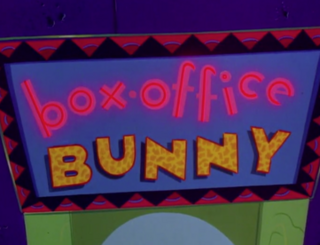
Box-Office Bunny is a 1991 Looney Tunes short film directed by Darrell Van Citters and starring Bugs Bunny, Daffy Duck and Elmer Fudd. It was shown in theaters alongside The NeverEnding Story II: The Next Chapter, as well as on the subsequent home media releases for the film. It is Warner Bros.'s first Bugs Bunny theatrical release since 1964's False Hare. It was issued to commemorate Bugs' 50th anniversary and is included as a special feature on the DVD for The Looney, Looney, Looney Bugs Bunny Movie. The short marks the debut of Jeff Bergman as the voice of Bugs, Daffy, and Elmer, following the death of Mel Blanc in July 1989.
Looney Tunes: Back in Action is a 2003 American live-action/animated comedy film produced by Warner Bros. Feature Animation and distributed by Warner Bros. Pictures. It is the second theatrical feature film in the Looney Tunes franchise, and was directed by Joe Dante from a screenplay by Larry Doyle. Brendan Fraser, Jenna Elfman, and Steve Martin star in the film; Timothy Dalton, Heather Locklear, and Bill Goldberg appear in supporting roles, while Joe Alaskey leads the voice cast. Its plot, which parodies action and spy film conventions, follows Bugs Bunny and Daffy Duck (Alaskey) as they become intertwined in a plot by the ACME Chairman (Martin) to transform the world's population into subservient monkeys using the Blue Monkey diamond. They accompany aspiring stuntman DJ Drake (Fraser) and Warner Bros. executive Kate Houghton (Elfman) on their journey to thwart the Chairman's plot, which doubles as a mission to rescue the former's abducted father, Damian (Dalton).

Granny is a fictional character created by Friz Freleng, best known from the Looney Tunes and Merrie Melodies animated short films of the 1950s and 1960s. She is the owner of Tweety Bird and, more often than not, Sylvester and Hector. Her voice was first provided by Bea Benaderet from 1950 through 1955, then by June Foray for almost 60 years then Candi Milo took over in 2017 following Foray’s death.

Daffy Duck's Quackbusters is a 1988 animated compilation film featuring classic Warner Bros. Cartoons shorts and animated bridging sequences, starring Daffy Duck. The film was released to theaters by Warner Bros. on September 24, 1988. It was the final theatrical production in which Mel Blanc provided the voices of the various Looney Tunes characters before his death in July 1989.

I Love to Singa is a 1936 Warner Bros. Merrie Melodies animated cartoon directed by Tex Avery. The short was released on July 18, 1936.

Book Revue is a 1946 Warner Bros. Looney Tunes cartoon directed by Bob Clampett. The cartoon was released on January 5, 1946, and features Daffy Duck.
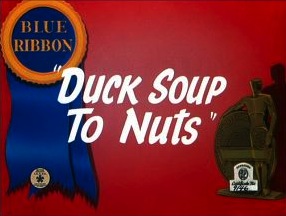
Duck Soup to Nuts is a 1944 Warner Bros. Looney Tunes cartoon directed by Friz Freleng. The cartoon was released on May 27, 1944, and stars Daffy Duck and Porky Pig.

Little Red Riding Rabbit is a 1944 Warner Bros. Merrie Melodies cartoon, directed by Friz Freleng, and starring Bugs Bunny. It is a sendup of the "Little Red Riding Hood" story, and is the first time in which Mel Blanc receives a voice credit.

The Looney Looney Looney Bugs Bunny Movie is a 1981 American animated comedy package film with a compilation of classic Looney Tunes/Merrie Melodies Warner Bros. cartoon shorts and animated bridging sequences produced and directed by Friz Freleng, hosted by Bugs Bunny. The new footage was produced by Warner Bros. Animation. It was the first Looney Tunes/Merrie Melodies film with a compilation of classic cartoon comedy shorts produced by Warner Bros. Animation.

My Favorite Duck is a 1942 color Warner Bros. Looney Tunes cartoon directed by Chuck Jones, in his second collaboration with writer Michael Maltese. The cartoon was released on December 5, 1942, and stars Daffy Duck and Porky Pig. It was the second color entry in the Looney Tunes series, and the first pairing of Porky and Daffy produced in Technicolor.

Conrad the Sailor is a 1942 Warner Bros. Merrie Melodies cartoon supervised by Chuck Jones. The title character, Conrad the Cat, is voiced by Pinto Colvig and animated by the quintet. The other featured player is Daffy Duck, voiced as usual by Mel Blanc.

My Little Duckaroo is a 1954 Warner Bros. Merrie Melodies theatrical cartoon short directed by Chuck Jones and written by Michael Maltese. The cartoon was released on November 27, 1954 and stars Daffy Duck and Porky Pig.
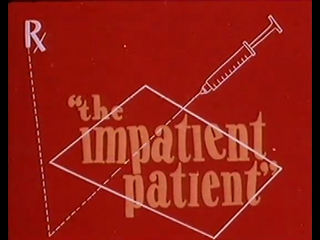
The Impatient Patient is a 1942 Warner Bros. Looney Tunes cartoon directed by Norman McCabe. The cartoon was released on September 5, 1942, and stars Daffy Duck. The film is set in a mad scientist's laboratory.
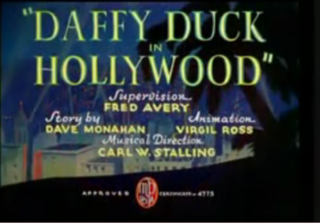
Daffy Duck in Hollywood is a 1938 Warner Bros. Merrie Melodies animated short directed by Tex Avery. The cartoon was released on December 12, 1938, and stars Daffy Duck. The short is Avery's last Daffy Duck cartoon.
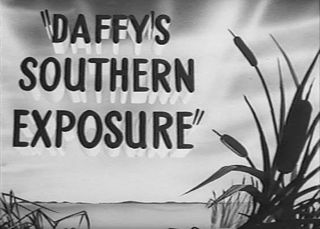
Daffy's Southern Exposure is a 1942 Warner Bros. Looney Tunes animated short directed by Norman McCabe. The cartoon was released on May 2, 1942, and stars Daffy Duck.
References
- ↑ Borowiec, Piotr (1 January 1998). Animated Short Films: A Critical Index to Theatrical Cartoons. Scarecrow Press. p. 204. ISBN 978-0-8108-3503-0.
- ↑ "The Daffy Duckaroo (1942): Cast". The Big Cartoon DataBase . Retrieved 6 August 2021.[ dead link ]
- ↑ "The Daffy Duckaroo Alternate Versions". 24 October 1942. Retrieved 22 January 2017– via IMDb.
- ↑ Beck, Jerry; Friedwald, Will (1989). Looney Tunes and Merrie Melodies: A Complete Illustrated Guide to the Warner Bros. Cartoons. Henry Holt and Co. p. 134. ISBN 0-8050-0894-2.
- ↑ Lenburg, Jeff (1999). The Encyclopedia of Animated Cartoons . Checkmark Books. pp. 70-72. ISBN 0-8160-3831-7 . Retrieved 6 June 2020.